Packet Pickup Strategies That Work: A "Good, Better, Best" Guide for Race Directors
Your race doesn’t begin at the starting line — it begins when a runner walks into packet pickup. A smooth, professional packet pickup builds excitement and confidence. A chaotic one creates frustration before the race even starts.
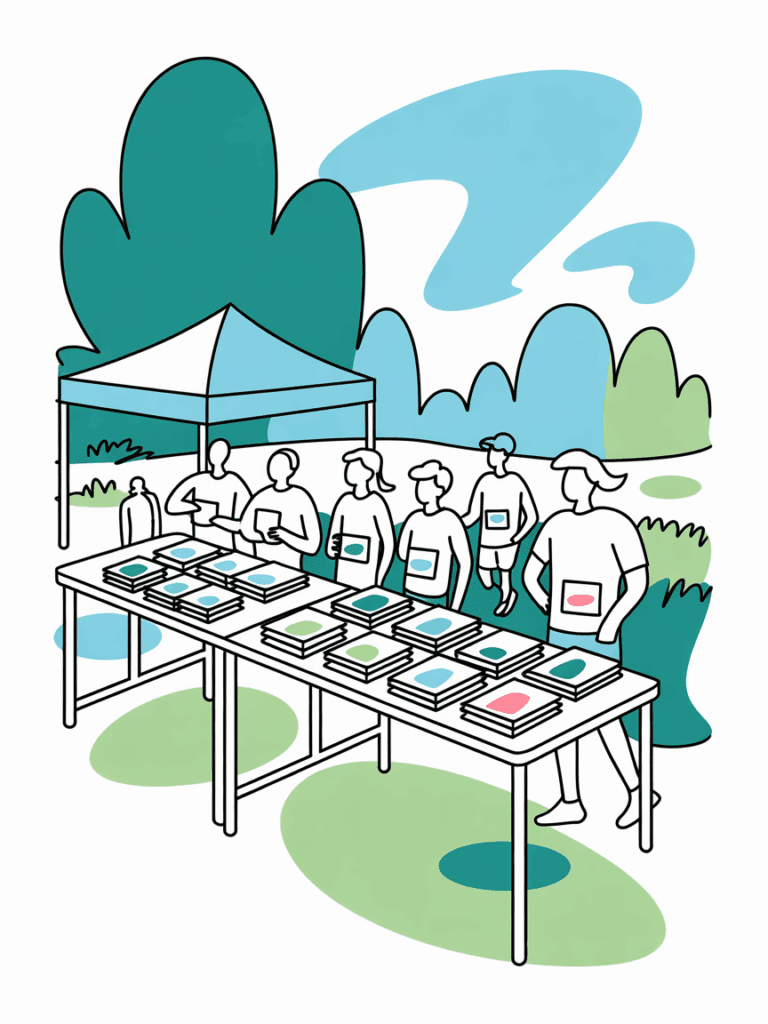
This guide breaks down the packet pickup process step-by-step, showing how race directors can evolve from “Good” systems that work, to “Better” systems that streamline, to “Best” systems that impress.
Each section includes challenges to avoid, ideal volunteer roles, and essential checklists. Use this as your roadmap to deliver a flawless pre-race experience.
The Packet Pickup Mindset
Think of packet pickup as your “first finish line.”
Every positive interaction builds runner trust.
Your volunteers are your race ambassadors — train them like team captains, not assistants.
1. Registration & Walk-Up Sign-Ups
Why It Matters: Registration sets the tone for every other packet pickup station. A well-managed system keeps lines moving, reduces data errors, and builds runner confidence from the start. The right approach depends on your comfort with technology and how tightly you want to control race-day logistics.
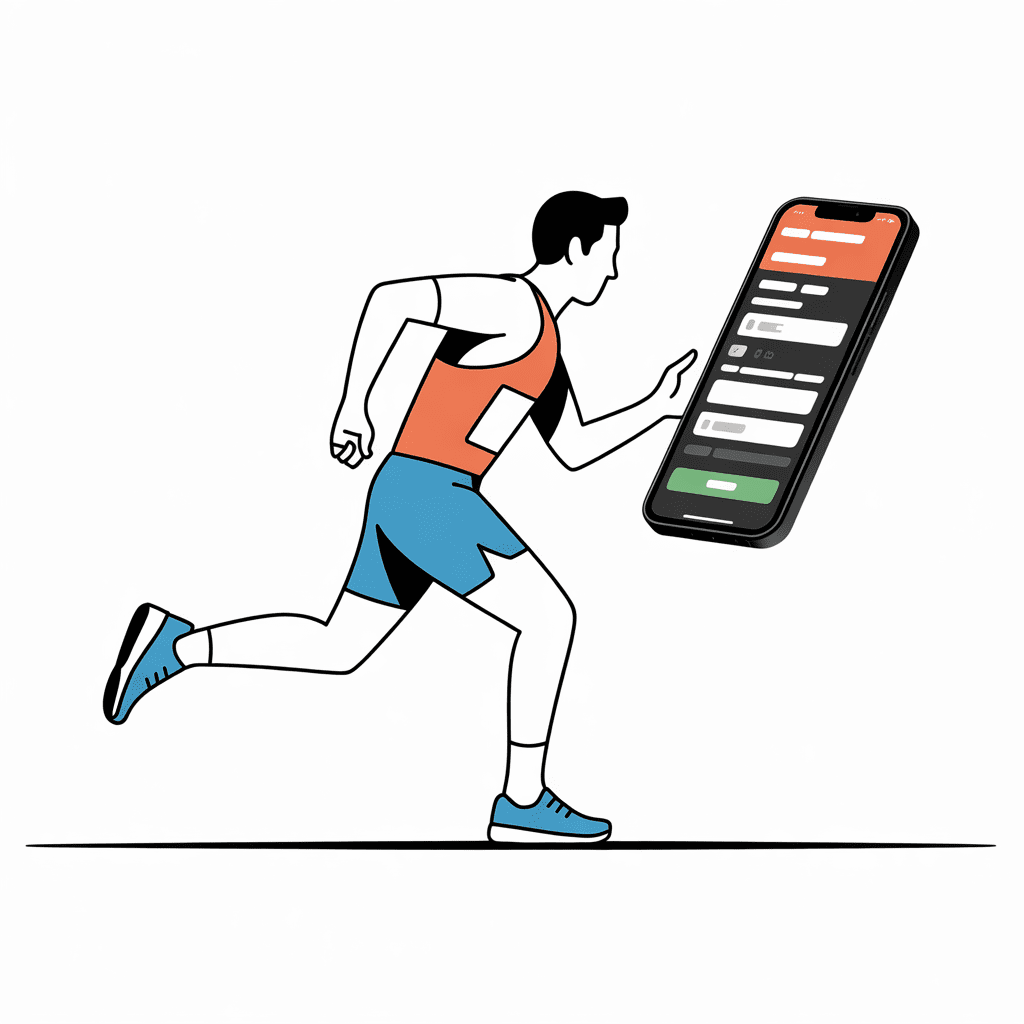
Good
Paper-Only Registration
Approach: Use printed registration forms, pens, and clipboards to collect participant details. Payments are made by cash or check.
Challenges:
- Slow processing speed and prone to handwriting errors
- Manual data entry required later
- Difficult to reconcile payments or verify duplicates
Volunteer Roles:
- Registration Clerk: Collect forms, verify waivers, handle payments
- Queue Manager: Direct runners and maintain order
- Data Entry Helper: Enter paper data post-event
Essential Checklist:
Print blank registration and waiver forms
Bring clipboards, pens, and small cash box for change
Organize completed forms alphabetically
Better
Electronic System with Day-Of Registration
Approach: Use laptops or tablets to process signups directly in an online registration system. Accept credit cards and digital payments on-site.
Challenges:
- Requires stable internet and power access
- Volunteers need familiarity with the registration software
- May cause short delays during payment processing
Volunteer Roles:
- Tech Volunteer: Set up tablets, manage logins
- Data Assistant: Guide runners through digital forms
- Payment Manager: Handle cash or card exceptions
Essential Checklist:
Enable same-day registration in your platform
Bring extra chargers, hotspots, and extension cords
Clearly label “Pre-Registered” vs “New Registration” lines
Best
Fully Electronic Registration with No Day-Of Sign-Ups
Approach: Close registration in advance and process all entries online. Only pre-registered runners appear in the digital check-in list.
Why It’s Best:
- Removes registration lines entirely
- Prevents data duplication or last-minute confusion
- Allows you to finalize bibs and shirts early
Volunteer Roles:
- Check-In Volunteer: Confirm pre-registered names via lookup or QR code
- Support Volunteer: Resolve exceptions (e.g., name spelling)
- Floater: Fill in at busy stations and keep flow balanced
Essential Checklist:
Communicate the registration deadline clearly to all runners
Print a backup roster as a failsafe
Test the online lookup tool before opening pickup
Common Mistake
Don’t rely solely on venue Wi-Fi. Always bring a backup hotspot and power banks. Congested venues can overload networks when hundreds of phones connect at once.
2. Bib Assignment & Lookup Strategies
Why It Matters: Your bib system connects the runner’s identity to their timing data and results. The more efficient your assignment process, the smoother your check-in flow and the fewer errors you’ll face on race day.

Good
Pre-Assigned Bibs
Approach: Assign bib numbers before the event and organize them by range or alphabetically.
Challenges:
- High prep workload and sorting effort
- Easy to misplace or duplicate numbers
- Difficult to modify for transfers or changes
Volunteer Roles:
- Bib Finder: Retrieve bibs by name or number range
- Verifier: Match runner details to bib
- List Recorder: Check off bibs as they’re distributed
Essential Checklist:
Label bins clearly by number range
Keep a printed list for quick lookups
Prepare blank bibs for replacements
Best
Dynamic Bib Assignment
Approach: Leave bibs unassigned until pickup. Volunteers assign the next available number through an online system or shared spreadsheet.
Why It’s Best:
- Eliminates pre-sorting time and errors
- Accommodates transfers, corrections, and walk-ups easily
- Keeps the bib inventory flexible and trackable
Volunteer Roles:
- Lookup Volunteer: Search runner in system and assign bib
- Recorder: Update records in real-time
- Verifier: Confirm details before handing over bib
Essential Checklist:
Test your lookup process thoroughly
Reserve a range of blank bibs for emergencies
Assign bibs sequentially to prevent gaps
Mailing BIBs
Consider offering a “bib mailing” option for runners who can’t attend packet pickup but will be present on race day. Mailing bibs in advance not only reduces on-site lines but also shows flexibility and professionalism — giving participants confidence that their race experience will be smooth from start to finish.
Teamwork Tip
Pair new volunteers with experienced ones during the first rush hour.
The extra set of eyes and hands ensures smooth training on live systems — and reduces early-day mistakes when lines are longest.
3. Bib Customization & Timing Method
Why It Matters: Your bibs are more than just numbers — they’re your connection between runners, timing, and branding. The right choice influences accuracy, event professionalism, and sponsor visibility.
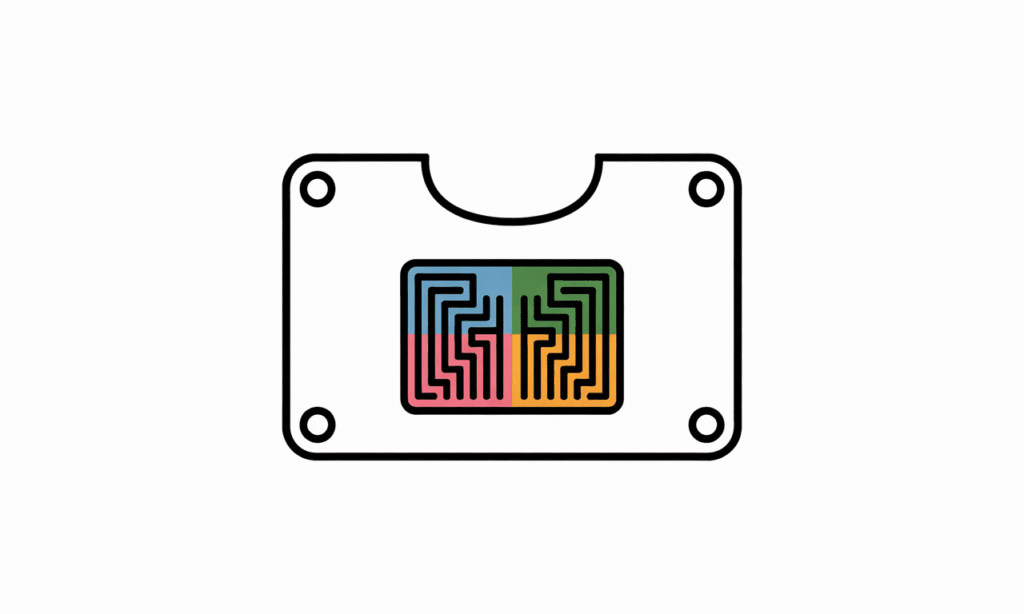
Good
Plain Bibs
Approach: Use standard numbered bibs without additional features.
Challenges:
- Manual timing process needed
- Lacks professional or branded appearance
- Missed opportunities for sponsor visibility
Volunteer Roles:
- Bib Distributor: Hand out bibs by number or lookup
- Timing Assistant: Record finish times manually
Essential Checklist:
Use waterproof materials
Keep spare bibs for no-shows or replacements
Better
Bibs with Pull Tabs
Approach: Include tear-off tabs for timing, raffles, or meal validation.
Challenges:
- Pull tabs can tear prematurely if handled roughly
- Volunteers must carefully track tab collection
Volunteer Roles:
- Bib Distributor: Ensure tabs remain attached during handout
- Tab Collector: Gather pull tabs at finish line
Essential Checklist:
Train volunteers on tab use
Provide containers for tab sorting at the finish line
Best
Chipped Bibs
Approach: Use bibs with embedded RFID timing chips for automatic, contactless results.
Why It’s Best:
- Provides instant, accurate timing data
- Reduces finish-line congestion
- Integrates seamlessly with most timing systems
Volunteer Roles:
- Bib Distributor: Confirm chip number matches registration record
- Tech Support Volunteer: Assist with chip verification if needed
Essential Checklist:
Test chip readers before event day
Coordinate unique chip IDs with your timing vendor
Design Insight
Custom bibs serve as race souvenirs and sponsor showcases. Even a simple QR code linking to results adds a modern, professional touch.
4. Swag & Sponsor Item Distribution
Why It Matters: Swag bags and sponsor items are an opportunity to delight runners and strengthen partnerships. Your approach determines how smooth your flow is — and how much effort you’ll spend before race day.

Good
Pre-Stuffed Bags
Approach: Assemble identical bags with shirts, swag, and sponsor items ahead of time.
Challenges:
- Requires extensive volunteer hours and storage space
- No flexibility for late sponsor arrivals
- Prone to shortages if counts aren’t tracked carefully
Volunteer Roles:
- Bag Assembler: Pre-pack items
- Quality Checker: Verify bag contents
- Distributor: Hand bags to runners
Essential Checklist:
Set strict sponsor delivery deadlines
Keep bags in cool, dry storage
Prepare a 10% buffer inventory
Better
Swag Table Pickup
Approach: Lay out sponsor materials on tables for runners to collect as they walk through.
Challenges:
- Creates minor congestion without direction
- Requires ongoing table management
Volunteer Roles:
- Table Attendant: Restock and monitor items
- Flow Director: Keep runners moving smoothly
Essential Checklist:
Group items by category or sponsor
Label tables clearly
Track inventory to restock popular items
Best
Expo-Style Distribution
Approach: Transform packet pickup into a mini-expo with sponsor booths and interactive displays.
Why It’s Best:
- Promotes community engagement and sponsor satisfaction
- Reduces volunteer packing workload
- Makes pickup an experience rather than a chore
Volunteer Roles:
- Expo Coordinator: Manage vendor setup
- Greeter: Welcome runners and answer questions
- Sponsor Liaison: Help vendors with logistics
Essential Checklist:
Plan booth layout for natural movement
Provide signage and power as needed
Assign setup times and load-in instructions
Bag Type Selection
Choose from drawstring bags, zip-top bags, eco-friendly paper totes, or reusable bags based on budget and sponsor expectations. Standard poly tote bags offer cost savings while maintaining professional appearance.
Sponsor Success
Invite vendors to run raffles or product demos. Runners engage longer, and sponsors gain more visibility — a win for both sides.
5. T-Shirt & Apparel Distribution
Why It Matters: Shirt distribution is often the slowest packet pickup station. Clear organization prevents size mix-ups, long waits, and frustrated runners.

Good
Shirts Pre-Stuffed in Bags
Approach: Include shirts in each runner’s pre-packed bag.
Challenges:
- Incorrect sizes can’t be changed easily
- Runners can’t verify their shirt before receiving it
Volunteer Roles:
- Bag Preparer: Match shirts to correct sizes during packing
- Distributor: Hand out completed bags
Essential Checklist:
Verify shirt data before stuffing bags
Post exchange policy signage
Best
Lookup or Voucher System
Approach: Give volunteers a lookup list or ticket noting shirt size. Runners collect shirts from a dedicated table by showing their bib or voucher.
Why It’s Best:
- Ensures accuracy and flexibility
- Simplifies size exchanges
- Streamlines volunteer workflow
Volunteer Roles:
- Shirt Volunteer: Retrieve shirts by size
- Swap Volunteer: Handle size changes
- Inventory Lead: Track remaining quantities
Essential Checklist:
Clearly label shirt bins by size
Maintain a backup supply of popular sizes
Record size changes in log
Volunteer Comfort
Provide fans, water, and shaded areas at shirt tables. Cool volunteers are alert volunteers — and happy volunteers keep lines moving.
6. Physical Layout & Traffic Flow Design
Why It Matters: Even the best system can collapse under poor layout. Designing your packet pickup flow prevents cross-traffic, bottlenecks, and weather-related chaos.
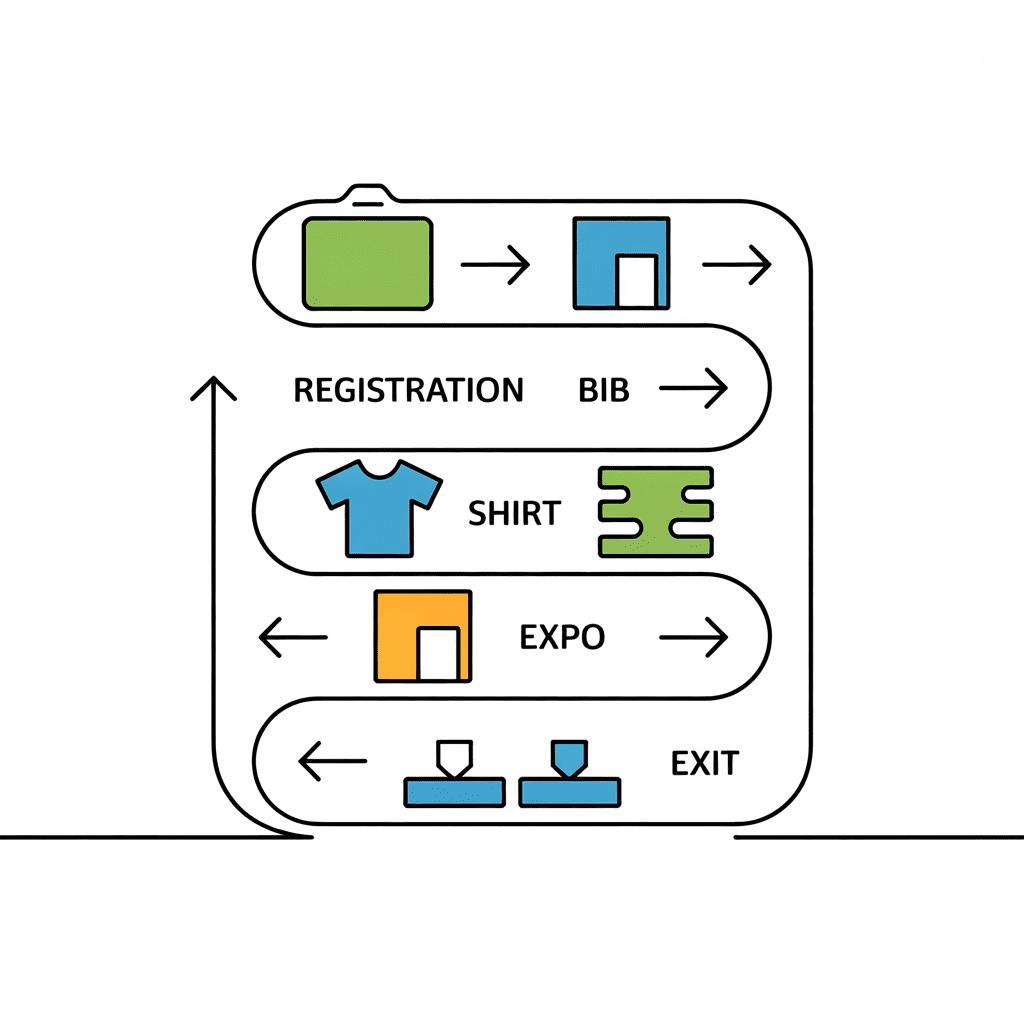
Good
One Tent for Everything
Approach: Use a single tent or table for all stations.
Challenges:
- Creates long lines and confusion
- Hard to manage problem cases without disrupting flow
Volunteer Roles:
- Multi-Task Volunteer: Handle bibs, shirts, and swag at once
- Queue Manager: Keep runners orderly
Essential Checklist:
Display bold signage for each step
Provide weather protection and airflow
Better
Separate Stations
Approach: Create dedicated areas for registration, bibs, shirts, and swag.
Challenges:
- Requires more space and staffing
- May cause cross-traffic if poorly mapped
Volunteer Roles:
- Station Lead: Manage one table each
- Greeter: Direct runners between stations
Essential Checklist:
Use directional arrows and signage
Plan overflow space for peak times
Best
Streamlined Flow with Expo
Approach: Create a linear path — Registration → Bib → Shirt → Expo → Exit.
Why It’s Best:
- Prevents backtracking or congestion
- Encourages natural progression through stations
- Supports sponsor engagement
Volunteer Roles:
- Flow Director: Monitor queues and reroute as needed
- Signage Volunteer: Maintain clear wayfinding
- Weather Lead: Adjust setup for changing conditions
Essential Checklist:
Print and distribute volunteer layout maps
Secure tents with anchors or weights
Include a dedicated problem-resolution station
Layout Strategies by Venue Type
Indoor Venue
Linear flow approach: Align tables in sequence, use stanchions and rope to control lines, place overhead signage for visibility.
Space-limited option: Combine registration + bib into a single step, then separate the shirt table.
Outdoor/Tented
Multi-tent series: Position tents so prevailing wind runs parallel to aisles, not perpendicular. Use overlapping tent coverage.
Lower-resource option: Single large tent partitioned inside with stations, or staggered small pop-ups.
Weather Contingency
Storm plan: Reserve indoor backup location (gym, community hall). Use tent sidewalls when needed, move critical stations under covered areas first.
Wind protection: Use ground anchors, sandbags, tie-downs. Keep signage low to avoid wind sail effect. Side panels provide additional stability.
Layout Tip
Before race day, walk through your packet pickup area from a runner’s perspective. If it feels confusing to you, it will feel worse to them.
7. Equipment & Technology Recommendations
Why It Matters: Technology simplifies packet pickup — but only if it’s reliable. Choosing the right equipment ensures speed, accuracy, and peace of mind.

Good
Manual Lookup
Approach: Volunteers check names against printed lists.
Challenges:
- Time-consuming for large crowds
- Susceptible to misspellings or duplicates
Volunteer Roles:
- Lookup Volunteer: Find names on paper lists
- Recorder: Mark off confirmed check-ins
Essential Checklist:
Print alphabetized lists
Keep pens and clipboards handy
Provide visible “Check-In” signage
Best
QR Code Scanning
Approach: Runners present QR codes from confirmation emails, scanned using phones or tablets.
Why It’s Best:
- Fast and error-free
- Works seamlessly with major registration platforms
- Simplifies recordkeeping automatically
Volunteer Roles:
- Scanner Operator: Scan codes using mobile devices
- Support Volunteer: Help runners find emails
Essential Checklist:
Test scanners before the event
Bring chargers and power banks
Keep printed backups in case of an outage
Tech Tip
You don’t need costly hardware — your team’s smartphones can scan QR codes instantly. Just test the feature in advance and keep devices charged.
8. Registration Platform Comparison
Why It Matters: Your registration platform defines what’s possible during packet pickup. Each system has unique tools, pricing, and capabilities that affect your workflow.
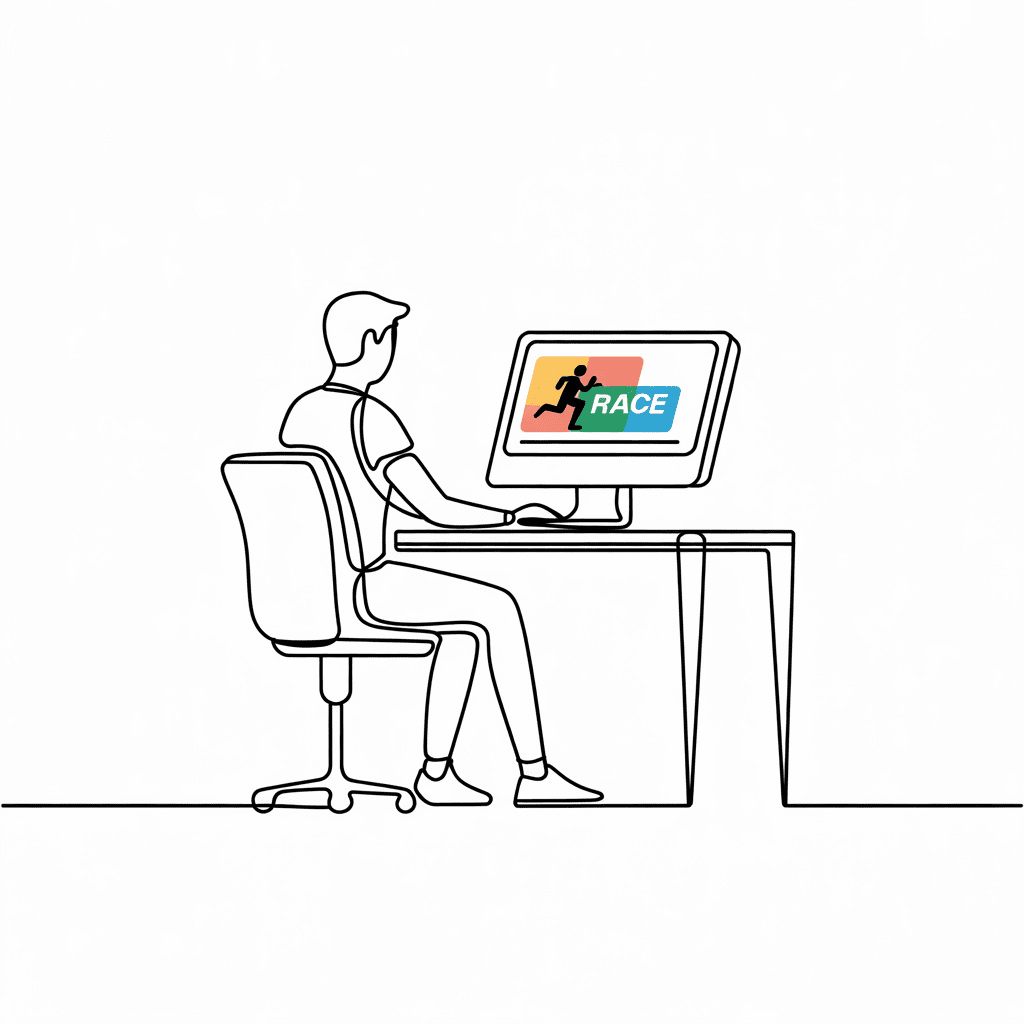
Platform Selection
If sponsors can cover the processing fees, go for a professional-grade system. If you’re self-funding, Webscorer offers an excellent low-cost all-in-one solution.
Choosing the Right Strategy
Budget estimates include shirts, bibs, swag items, equipment rentals/purchases, volunteer supplies, and venue costs. Actual expenses vary based on shirt quality, sponsor contribution levels, and existing equipment inventory.
Choose "Good"
for simplicity and minimal setup — reliable, but slower.
Choose "Better"
to integrate tech and reduce manual labor.
Choose "Best"
to deliver a polished, scalable experience that delights both runners and sponsors.
Each “Best” system creates smoother flow, fewer mistakes, and happier volunteers.
Implementation Checklist & Final Steps
Success comes from systematic preparation and execution. Use this comprehensive checklist to ensure nothing falls through the cracks as you prepare for packet pickup day.
1
Select Systems
Confirm your registration, bib, and swag strategies.
2
Test Technology
Verify scanners, software, and connectivity.
3
Assign Roles
Define who manages each table and backup.
4
Plan Layout
Map flow, mark signage, and set overflow zones.
5
Prepare Supplies
Count bibs, shirts, swag, and extras.
6
Communicate Early
Send runner instructions and pickup times.
7
Conduct Mock Pickup
Practice check-ins before the public arrives.
8
Debrief Afterward
Capture lessons for continuous improvement.
Day-of Success Factors
Monitor & Adapt
- Watch for queue buildups at any station
- Reassign volunteers from slow stations to bottlenecks
- Open additional parallel stations during peak periods
- Keep team leads mobile with radios for quick coordination
- Track inventory levels continuously, especially popular shirt sizes
Handle Issues Quickly
- Designate problem-resolution area separate from main flow
- Have a table designated to handle special cases like if someone wants to change their race distance
- Empower volunteers to make reasonable accommodations
- Have tech support person for equipment issues
- Keep backup supplies accessible (pens, forms, bibs, shirts)
- Maintain positive energy even during high-stress moments
Final Thoughts for Race Directors
The packet pickup experience sets expectations for your entire event. Invest the time to build reliable systems, train your team thoroughly, and execute with confidence.
A smooth packet pickup creates excited, relaxed runners who arrive at the starting line ready to race. That’s worth every minute of preparation.
Have runners go into the race with confidence that it’s well put together!
Remember
Start simple and scale up as your race grows. Perfect execution of a basic system beats failed execution of an overly complex one. Document what works and what doesn’t after each event. Continuous improvement creates excellence over time.



